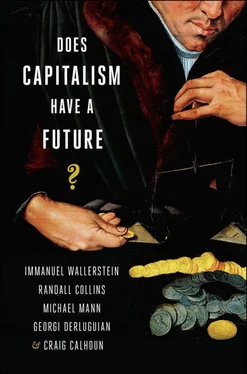Immanuel Wallerstein - Does Capitalism Have a Future?
Здесь есть возможность читать онлайн «Immanuel Wallerstein - Does Capitalism Have a Future?» весь текст электронной книги совершенно бесплатно (целиком полную версию без сокращений). В некоторых случаях можно слушать аудио, скачать через торрент в формате fb2 и присутствует краткое содержание. Город: New York, Год выпуска: 2013, ISBN: 2013, Издательство: Oxford University Press, Жанр: Публицистика, sci_economy, на английском языке. Описание произведения, (предисловие) а так же отзывы посетителей доступны на портале библиотеки ЛибКат.
- Название:Does Capitalism Have a Future?
- Автор:
- Издательство:Oxford University Press
- Жанр:
- Год:2013
- Город:New York
- ISBN:978-0-19-933084-3
- Рейтинг книги:5 / 5. Голосов: 1
-
Избранное:Добавить в избранное
- Отзывы:
-
Ваша оценка:
- 100
- 1
- 2
- 3
- 4
- 5
Does Capitalism Have a Future?: краткое содержание, описание и аннотация
Предлагаем к чтению аннотацию, описание, краткое содержание или предисловие (зависит от того, что написал сам автор книги «Does Capitalism Have a Future?»). Если вы не нашли необходимую информацию о книге — напишите в комментариях, мы постараемся отыскать её.
Does Capitalism Have a Future? — читать онлайн бесплатно полную книгу (весь текст) целиком
Ниже представлен текст книги, разбитый по страницам. Система сохранения места последней прочитанной страницы, позволяет с удобством читать онлайн бесплатно книгу «Does Capitalism Have a Future?», без необходимости каждый раз заново искать на чём Вы остановились. Поставьте закладку, и сможете в любой момент перейти на страницу, на которой закончили чтение.
Интервал:
Закладка:
I am not proposing that our recent problems are the beginning of the end of capitalism. We will no doubt ride out this crisis, like other crises, in the short run, while leaving a certain amount of long-term damage. Financial crisis has been widely discussed. What I want to examine here is not short-run crises but the contributions of financialization to the displacement of middle-class labor.
Recent financial manipulations are examples of a deeper structural tendency in capitalism: the pyramiding of meta-markets upon each other in financial markets. Capitalism, ever since it entered its phase of self-sustaining growth or internally driven expansion, has connected markets for material goods and services with markets for financial instruments. Schumpeter [1939] defined entrepreneurial capitalism as enterprise carried out with borrowed money. Static markets merely reproduce existing stocks and workforces, unless new combinations are taken out of the circular flow of reproduction; this is done by borrowing against the future. Thus in Schumpeter’s [1911] view, banks are the headquarters of the capitalist system, deciding where new allocations for development will be made. But since financing is intrinsically speculative, its relationship with existing material arrangements can vary enormously. The upper atmosphere of the financial system can have many multiples of the value of what is actually bought and sold in material goods and services; we see this, for instance, in the vast amounts of money in international currency speculation in relation to the size of GDP, or the extraordinarily inflated sums in hedge funds, especially before the 2008 crash.
By pyramiding meta-markets I mean the historical tendency for any given financial market to give rise to a higher-order market in lower-order financial instruments. In real social practices, all monies are promises to pay in the future. Thus financial specialists can create promises to pay promises to pay, and so on up to almost any level of complexity. Loans, liens, equities, bonds, all these are relatively low levels of pyramiding. Short-selling stock market shares, bundling mortgages for secondary resale markets, leveraged buyouts, mutual funds, hedge funds, and other complex trading schemes are higher-order markets built upon the instruments of exchange. There is in principle no upper limit to how many layers can be added. Very large sums can be generated at higher levels, although the conversion of these monies into low-level goods and services is problematic. The illusion is created because they are all designated by the same unit of account—dollars, pounds, Euros—but these nominal amounts can rise so high that cashing them out in the real material world is literally impossible.
Pyramided financial markets have a high degree of social constructedness. Of course almost everything is socially constructed in some way, but some are much more remotely connected to material constraints than others. An army, for instance, has an important degree of social constructedness, especially in combat, where, as Napoleon said, the moral is to the material as three to one; nevertheless, an army with five times the size and weaponry of its opponent will almost always win, provided it maintains some minimal degree of social cohesion. In the world of pyramided financial instruments, the moral (i.e., the interactional processes of the network and its emotional moods) is to the material economy as something on the order of from six to one (which is the ratio between money loaned out and actual bank deposits) up to quite possibly hundreds to one in highly leveraged financial manipulations. As sociologists, we need to look at social constructedness not as a philosophical constant but as a set of variations, which can be theorized both in their static relationship to network structures, and in their dynamics of boom and bust over time.
My chief point here is that the more pyramided financial meta-markets are, the more volatile and crisis-prone they are, with booms and busts far out of proportion to what is happening in the low-level material economy. But there is an optimistic side as well—optimistic if you would like to preserve capitalism. Financial markets are intrinsically flexible, like giant balloons made out of magic material that can inflate to any size at all. This lends plausibility to the idea that everyone can become a finance capitalist, playing the great game of financial markets. And indeed popular participation in financial markets has grown a good deal during the late 20th century and the early 21st, through employee pension funds, millions of small stock market investors, and speculating through mortgaged home ownership in the Ponzi scheme of the inflationary housing market.
How far can this go? Can it save capitalism? It would surely be a rocky road, given the inherent volatility of financial markets, their tendency to booms and busts. This has been a long-term historical pattern, ever since the Dutch tulip investment mania in 1637 and the South Sea bubble in 1720. Speculative collapses have been so common that Schumpeter [1939] regarded business cycles as intrinsic to capitalism, and their presence a historical marker of the existence of self-driven capitalist dynamics. One could turn the historical argument around; speculative busts have always bottomed out and eventually financial markets have gone up again. Financial crises are in the nature of the capitalist beast, and the historical record suggests that we will always recover from any financial crisis. Again we have an empirical generalization without good theoretical basis. What happens when financial crisis is coupled with structural depletion of middle-class jobs, and a technological displacement crisis throughout virtually the entire labor force? Can income from the financial sector reach so far that it supplants salaries and wages as the primary source of income for everyone?
There are two possibilities here: either everyone becomes a capitalist living off of investment returns, or the financial sector itself becomes the major area of employment (i.e., the growth of financial labor). Taking the first of these, it is hard to envision a future in which everyone lives as a financial investor. It takes some initial accumulation of funds for your initial bankroll in order to start investing, the gambling stakes to get into the game. Small investors get started with their salaries, savings, and pensions; but these are just what would dry up under the technological displacement scenario. We are at the theoretical frontier here, and the future of political economy may well include things undreamed of in your philosophy, Horatio. But is it conceivable that in the future when everything is automated that entire populations will spend their lives as financial investors, a reserve army of gamblers in lifelong casinos? Not everyone goes on making money throughout their investment career; some people lose their investments even in good times, and during a speculative bust many people do. And once they wash out of the speculative market, do they ever get back in, barring gainful employment on their own?
Financial markets are intrinsically inegalitarian, concentrating wealth in the small number of big players at the top of the pyramid. It is precisely the advantage of better networking, insider viewpoint, first-mover advantages, and ability to ride out fluctuations better than small players that gives big players in higher meta-markets their capacity to make profits from the medium and small players in lower-order markets. Pyramided levels of monies illustrate Viviana Zelizer’s [1994] theory that money is not homogeneous but plural, diverse sets of specific currencies circulating within their own social networks. Those who play in the circuit of hedge funds, for instance, are a very restricted group of persons and organizations; small players are not even legally allowed into these markets. Perhaps this is beside the point; in the idyllic financial utopia of the future, core investors will become mega-rich, but smaller investors will get their share. Will this be enough to sustain consumer spending throughout the entire economy and thus keep the machinery of capitalism going? Not if financial markets tend toward ever-greater concentration, exploiting the smaller participants at the bottom.
Читать дальшеИнтервал:
Закладка:
Похожие книги на «Does Capitalism Have a Future?»
Представляем Вашему вниманию похожие книги на «Does Capitalism Have a Future?» списком для выбора. Мы отобрали схожую по названию и смыслу литературу в надежде предоставить читателям больше вариантов отыскать новые, интересные, ещё непрочитанные произведения.
Обсуждение, отзывы о книге «Does Capitalism Have a Future?» и просто собственные мнения читателей. Оставьте ваши комментарии, напишите, что Вы думаете о произведении, его смысле или главных героях. Укажите что конкретно понравилось, а что нет, и почему Вы так считаете.












